New hope for our tiniest homeless
August 30, 2012
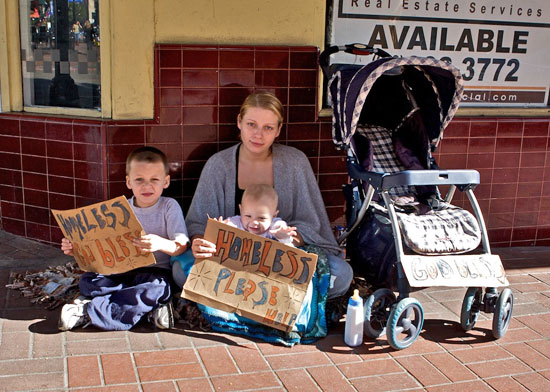
A $25 million committment by First 5 LA holds the promise of housing and services for young homeless children.
There are an estimated 3,000 children—5 years old and younger—who endure lives of homelessness every day in Los Angeles County. By all measures, they face a bleak future. According to studies, homeless youngsters are 12 times more likely to end up in foster care, and they’re twice as likely to suffer learning disabilities. By the age of 12, large numbers of them will have witnessed a violent event.
This week, the First 5 LA commission began developing the framework for an unprecedented “fast-track” effort to end this tragic cycle by committing $25 million to place families of these vulnerable youngsters in permanent supportive housing.
“There is a tremendous social cost for nearly 3,000 of our youngest children to be left without a safe, stable home every night,” said Supervisor Zev Yaroslavsky, who earlier this year became First 5 LA’s chairman. “With this program, we are focusing for the first time on helping families with children prenatal to age 5 who are struggling with homelessness daily and nightly in Los Angeles County.”
The multimillion dollar effort was initiated in July through a Yaroslavsky motion after First 5 LA released a study of the problem. It’s modeled after programs that have proven highly effective in restoring the lives of chronically homeless adults in Los Angeles and across the nation. The idea is to give a person a permanent home while surrounding him or her with a variety of services, including mental health and medical services.
A Los Angeles County analysis of the pioneering Project 50 on Skid Row showed that not only were participants benefiting, but the public was saving money on emergency rooms, jails and other costs associated with long-term homelessness. The Project 50 model, also championed by Yaroslavsky, is now being replicated throughout the region and by the U.S. Department of Veterans Affairs.
The $25 million committed by First 5 LA to house homeless children is part of a broader initiative to accelerate the expenditure of $400 million for various services aimed at the county’s babies, toddlers and preschoolers. Last year, a toughly-worded audit found, among other things, that the agency had been sitting on a surplus of nearly $800 million, prompting a change of leadership. First 5 LA and similar agencies throughout California are funded by a voter-approved 50-cent tax on tobacco products sold in the state.
At its meeting this week, the commission said it would begin soliciting applications for the funds in mid-September and start awarding the money in December.
Carmageddon, meet ARTmageddon
August 28, 2012
Last summer, Southern Californians learned the art of dodging a 53-hour freeway shutdown. Now, as Los Angeles braces for a follow-up 405 Freeway closure, a collective of arts groups is offering an even more creative response.
As crews prepare to close ten miles of the 405 Freeway on September 29 and 30, more than 100 arts groups are planning a weekend-long celebration of local art and culture, highlighting thousands of offerings from mariachis at the Ford Theatres to organ recitals at Pomona College to flash mobs in Long Beach.
“People here drive across town to theaters and museums and movies,” says Diana Wyenn, marketing and media relations manager at REDCAT, a participant in the campaign. “But they often don’t even notice the local galleries or theaters just a few blocks away that put on incredible shows.”
Working with the online listings database Experience LA, Metro, the Los Angeles County Arts Commission and others, the consortium is inviting Southern Californians to help create “the biggest art pARTy of the year” by patronizing the arts in their communities or taking public transportation to an art event nearby.
An ARTmageddonLA.com web site, currently being constructed, will guide Carmageddon II refugees to performances, concerts, exhibitions and screenings that are accessible by Metro, or—better yet—down the street from their own homes.
“We live in an arts metropolis, and we rarely stop to pay attention to it,” says Ezra LeBank, a CSU Long Beach theater arts professor who conceived ARTmageddon with Wyenn. “This is the moment when we can move above the constant buzz of busyness in L.A. and embrace local arts.”
Wyenn and LeBank, who are both arts advocates and artists, say their idea rose from a discussion with friends last autumn about the difficulty artists have in promoting their work across Southern California’s sprawl.
“We’re so separated physically that it’s hard to feel community, as artists or audiences,” LeBank says. “We often don’t feel a sense of togetherness, and we started playing with that idea.”
LeBank says they discussed a collaboration that might draw from throughout the region, and timing it to coincide with “a moment or a day when people were all paying attention to one thing and united that way.”
Then they remembered how Carmageddon seized the public imagination last summer—and that Carmageddon II was coming.
“It was perfect because it’s going to be the central event in L.A. for that weekend—and it’s a moment that’s all about stopping,” he says.
The result is the latest effort—from CicLAvia to Pacific Standard Time to the Watts Village Theater Company’s Meet Me At Metro—to encourage Angelenos to think locally and to create a sense of community and human-scaled connection across L.A.’s vast geography. It’s low budget because the date for Carmageddon II wasn’t announced until July, Wyenn says, so they had no time to fundraise.
Nonetheless, so many L.A. artists and advocates quickly joined the effort, she says, that getting the word out via social media and word-of-mouth hasn’t been a problem. Volunteers from organizations such as the Circle X Theatre Company, the Center Theatre Group and Grand Performances are involved already, and the list has been growing daily. (Organizations, artists and businesses interested in being included when the web site goes live are encouraged to contact the team at [email protected] or visit the ARTmageddon web site or Facebook page.)
LeBank, who teaches movement, says his students will be performing on campus that weekend at Cal State Long Beach State, and putting on “flash mob-type performances” around the community. Wyenn is excited about “Butoh Meadow::Meadow Butoh,” a piece in which more than 50 people covered in flour plan to cross Silverlake Meadow, and the final performance of “Rodney King” at the Bootleg Theatre that weekend. But surprises await in every neighborhood.
Topanga denizens may want to check out “The Women of Lockerbie” at the Will Geer Theatricum Botanicum that weekend. Mid-Wilshire types might want to stroll over to the Mimoda Studio Theater’s African dance show, “The Essence”. The New Short Fiction Series will be presenting short stories about the LA driving experience at the Federal Bar in NoHo.
“There are galleries everywhere, some of which I know are planning ARTmageddon parties, and people will be playing music in public spaces,” LeBank says. “There’s a lot more happening than people realize.”
Posted 8/28/12
A Modernist icon and the kid next door
August 28, 2012

The Hall of Records is a mid-Century classic in the heart of downtown—but its upkeep is an ongoing challenge.
As the county Hall of Records hits the big 5-0 this year, it’s getting a youthful new neighbor and a second look by a public that’s been largely unaware of its towering architectural stature—and its aging condition.
Unbeknownst to many in the Civic Center crowd, the 1962 building is a striking example of Modernist architecture and ahead-of-its-time eco-design by the legendary Richard Neutra with his then-partner Robert Alexander.
Now that Grand Park, with its splashy pink furniture and high visibility quotient, is set to open its next segment right next door to the Hall of Records on September 11, a new generation of Angelenos is about to meet up with a structure that Los Angeles Times architecture critic Christopher Hawthorne describes as being “among the most underrated modernist buildings in Los Angeles.” There’s even talk of screening outdoor movies and concert simulcasts on the Hall of Records wall that faces the new Community Terrace section of the park.
“Bringing more people into the area is a good thing and will change how people view [the building],” said Linda Dishman, executive director of the Los Angeles Conservancy. Although she says the Hall of Records is “very much admired”—and eligible for listing on the California Register of historic resources—it’s less visible than other downtown Modernist favorities like architect A.C. Martin’s Department of Water and Power Building, not to mention Frank Gehry’s internationally acclaimed Walt Disney Concert Hall.
“Buildings that people can see from the freeway, they really tend to care about,” Dishman said.
Although it’s been keeping a low profile, the 15-story Hall of Records is a busy place, bustling with workers from eleven county departments. But its signature tenant, the Registrar-Recorder/County Clerk, picked up stakes and moved to Norwalk years ago, along with the records that gave the building its name.
And some signature elements of the building’s architecture are now broken, repurposed or out of public view, although many of its glories remain (see photo gallery below.)
Its most compelling features—massive solar-activated aluminum louvers, designed to move with the sun and keep the offices inside shaded—have been locked into place for more than two decades. The building’s manager says they’re “beyond economical repair.”
In a digital age, the windowless wing of the T-shaped building that was built to hold records now tends to hold mostly county workers instead.
A cafeteria on the building’s top floor, with its dramatic “spider leg” exterior columns and broad balcony showcasing killer views, has long since stopped dishing up lunch for bureaucrats. Instead, it’s been transformed into office space for Superior Court witness and juror services.
The Hall’s “Mad Men”-era lobbies have seen better days, too—though they still exude enough early ‘60s fabulousness to attract film and TV crews galore. (“The Lincoln Lawyer” shoot left behind spruced-up light fixtures and a series of oversized Los Angeles-themed photos in a glass case.)
And the exterior lighting that once illuminated the building’s Hill Street facade? It’s out of order, with a bench pulled over the fixtures so no one trips on them. “It’s on the list for repair,” sighs Charlie Bedell III, chief of the District Attorney’s Property Management Division. The D.A.’s office, which now occupies most of the office space in the Hall of Records, is charged with the often thankless task of maintaining the building. Other tenants range from the Alternate Public Defender and the Auditor-Controller to Regional Planning and the Treasurer-Tax Collector.
Still, there are signs that things are perking up: fresh landscaping around the building looks bright and healthy. A mosaic-and-granite mural by artist Joseph Young on the north side of the building was restored by a conservator hired by the county Arts Commission in 2008 (although it’s due for another cleaning soon.)
And, while the general public may be only vaguely aware of the Hall of Records’ existence, Hollywood location scouts have placed it on the A-list.
“Everybody wants to come to this building to film,” Bedell said. “They love the old architecture of this building. They love the uniqueness of this building.”
Hollywood also loves what’s not readily visible—the subterranean world of tunnels connecting the building with the Hall of Administration, the Hall of Justice and the Criminal Courts building.
“Most people don’t know these tunnels exist,” Bedell said, although they’ve been seen in features ranging from “Eagle Eye” to “National Treasure.”
With a long list of maintenance needs, and a short supply of funds, a top priority is repairing the tunnel doors so they can be secured after-hours—of particular importance now that a public underground parking lot serving Grand Park has opened right next to the Hall of Records.
But there’s so much left to do. The building’s deterioration frustrates Neutra’s son, architect Dion Neutra, who bemoans the non-functioning louvers, the “abandonment” of the rooftop cafeteria, the lobbies “all festooned with crap and signs.” His Vienna-born father worked for much of his career in Southern California, creating striking residences and office buildings that helped establish a signature mid-century aesthetic in Los Angeles, Orange County, Palm Springs and other areas. Some of Neutra’s buildings have been destroyed, and preserving his legacy requires vigilance. (Efforts to stop the planned demolition of Neutra’s Cyclorama Building at Gettysburg National Military Park in Pennsylvania are underway.)
In that context, the upkeep of the Hall of Records takes on new urgency, Dion Neutra said.
“Why would a steward of a building like that, with millions of dollars of original cost, allow it to deteriorate like that?” he asked. “It just doesn’t make sense.”
The significance of the building goes beyond its architectural pedigree. Integrated into the Hall of Records are two artworks from the county’s Civic Art collection: the Joseph Young mural and a dramatic eight-story-high screen by ceramicist Malcolm Leland that covers the building’s ventilation system.
Clare Haggerty, the Civic Art collections manager for the county Arts Commission, said she would like to see plaques installed on both artworks, to inspire passersby to take a deeper look at what’s in front of them. In the process, they might just see the Hall of Records itself in a whole new light.
“I would say that, like a lot of our artworks, sometimes to appreciate them, you need to know a little of their backstory,” Haggerty said. “It’s actually pretty amazing.”
Photos by Henry Salazar/Los Angeles County
Posted 8/28/12
Return of Carmageddon
August 27, 2012
Carmageddon, last summer’s blockbuster traffic success story, is back with a fall sequel. And to keep Part II from turning into the disaster predicted—and averted—the first time around, officials say it will be more important than ever to go “car-light” or “car-free” during the last weekend in September.
Starting around 7 p.m. on Friday, September 28, ramps to the 405 Freeway will begin closing in advance of a weekend-long shutdown of the entire freeway through the Sepulveda Pass.
The full, 10-mile stretch of the 405 running from the 10 Freeway to the 101 will be closed all of Saturday, September 29, and Sunday, September 30. It is set to reopen at 5 a.m. on Monday, October 1.
Avoiding epic gridlock for a second time may be a tall order, but officials said they are confident the public can pull it off.
“During Carmageddon I, drivers proved the skeptics wrong,” said Supervisor and Metro Director Zev Yaroslavsky. “They heard our warnings and stayed off the roads…And I have every confidence they’ll rise to the occasion again.”
The planned 53-hour closure of the freeway is needed to dismantle the north side of the Mulholland Bridge over the 405. The south side was demolished last summer, but it has taken longer than expected to rebuild, leading to delays in scheduling Carmageddon II.
Picking a suitable weekend meant juggling around big dates like the start of the fall quarter at UCLA (September 24) and transporting the Space Shuttle Endeavor from LAX to the California Science Center in Exposition Park (likely sometime in October.)
The weekend of September 29-30 “was the least impact, that we could tell,” said Mike Barbour, who’s heading up the project for Metro.
The project is part of a major, multi-year effort to build a 10-mile northbound carpool lane on the 405 Freeway, along with other improvements, including redesigned flyover ramps at Wilshire Boulevard. Overall, the project is running four to six months behind schedule, but officials are optimistic they can make up some of that time and still reach “substantial completion” next year.
Work wrapped up 17 hours early during the first Carmageddon—a pleasant surprise that’s unlikely to be repeated this time around, Barbour said.
“There’s more to knock down and more to remove,” he said, adding that workers also will be taking advantage of the lengthy closure to get a jump on maintenance and construction work elsewhere on the freeway.
“The project is pushing to get this job done as soon as possible,” he said, “so we can get out of everybody’s hair.”
Posted 7/19/12
Your guide to Carmageddon II
August 27, 2012
Whether you’ve been following every twist and turn of the 405 Project as it progresses or are just trying to catch up on the latest strategies for coping with Carmageddon II, an upcoming community meeting can help.
At the September 6 meeting, officials will present information about all the closures, detours and alternative routes being developed as Los Angeles gets ready to navigate the second coming of Carmageddon. That long-running closure of the entire 405 Freeway between the 10 and the 101 takes place the last weekend in September.
The first ramps will begin closing at 7 p.m. on Friday, September 28. The full freeway will be closed on Saturday, September 29, and Sunday, September 30, and is set to reopen at 5 a.m. on Monday, October 1. The closures are needed so workers can demolish the north side of the Mulholland Bridge over the freeway—part of a wide-ranging project to bring a northbound carpool lane and other improvements to the stretch of the 405 that runs through the Sepulveda Pass.
The community meeting will take place at Ahmanson Hall in the Skirball Center, 2701 North Sepulveda Boulevard. Free parking will be available in the north garage on the Skirball grounds, and in the east garage on the east side ofSepulveda Boulevard.
During the original Carmageddon last summer, motorists heeded the official warnings about staying off the roads and things turned out better than expected. This time around, the message to the public has been tweaked and officials are advising people to “Plan Ahead, Avoid the Area, or Eat, Shop and Play Locally.”
Posted 8/27/12
Extinct, but still roaring
August 27, 2012
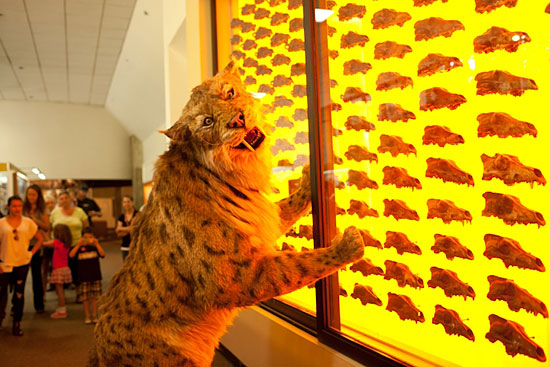
Things are getting wilder at the Page Museum with the arrival of a new show featuring Ice Age puppets.
Call it morbid curiosity. There’s a brave saber-toothed cat on its way to the La Brea Tar Pits, where thousands of its kind met a sticky prehistoric demise. The new cat—actually a mechanized puppet of the extinct Smilodon fatalis—is the star of the live educational show Ice Age Encounters.
The show and the puppet got their start at the Natural History Museum, where they entertained about 45,000 guests in 2011. The Page Museum, located at the Tar Pits, aims to make the Ice Age show a hot ticket in its new location.
“We’re hoping our show will bring more audiences to the Page, especially school groups and families on the weekend,” said Peter Wylie, who manages the show. “It provides a nice, easy introduction to help people appreciate all of the various artifacts throughout the museum.”
Museum paleontologists bring scientific legitimacy to the performance, incorporating the latest theories on the animals’ appearance and behavior while providing details about how the cats became trapped and fossilized. The performances will add a new dimension to the museum, which is also an active laboratory for fossil excavation, repair and identification.
The saber-toothed cat was built in Jim Henson’s Creature Shop, famous for breathing life into the Muppets and the monsters from Where the Wild Things Are. Operating the life-sized puppet requires two people working together. An actor is harnessed into the 70-pound contraption and outfitted with forearm stilts. A second puppeteer works the robotic head—which bites, blinks and roars—by remote control. A cub, controlled marionette-style, is part of the act, too.
Audiences will watch Ice Age Encounters and other museum programs in The Page’s newly-renovated East La Brea Theater, which Wylie says provides an “intimate, up-close” experience with brand-new technology.
Sneak preview performances will be held at 11 a.m., 12:30 p.m. and 1:45 p.m. on Labor Day, Monday, September 3. Regular performances on Wednesdays and Saturdays start September 12. Details are here. The show is free with admission to the museum.
Posted 8/27/12
A decision on my future
August 22, 2012
For many months, I’ve been wrestling with one of the most difficult decisions of my political life—whether to run for the office of Mayor of Los Angeles. I’ve been urged to enter next year’s race by friends, supporters and residents throughout the city. And I’ve been humbled and touched by the confidence they’ve placed in me.
I’m a lifelong resident of Los Angeles, a city facing serious challenges and opportunities. I have no doubt that, with my expertise and experience, I could help transform L.A.’s fortunes. In the end, however, it is this very length of service that has tipped the scales for me.
By the end of my current term on the Board of Supervisors in December, 2014, I will have served the people of the city and county of Los Angeles for nearly 40 eventful, productive and fulfilling years. Beginning as a 26 year-old councilman, I have quite literally come of age in public life at the forefront of Los Angeles’ most critical issues. While I have never been a supporter of term limits, I do believe that four decades is long enough for any citizen to hold elective office, especially in an executive capacity.
So I’ve made the decision to complete my current term on the board and then move on to the other things I’ve longed to do outside the political arena while I have plenty of productive years ahead of me. Simply put, it’s time for a new generation of leaders to emerge and guide this region into the future.
I want to thank the many people who have given me advice and encouragement during the period that I have weighed this decision. I deeply appreciate their patience and understanding. I also want to thank the voters who have elected me 11 times and given me the privilege of representing them. Above all, I’m eternally grateful to my family, which has encouraged me every step of the way while sacrificing so much.
Now, with that said, let me be clear: I’m not finished yet. I have more work to do and very little time in which to complete it. My dedicated staff and I will give our all during the next 27 months to get the job done. I look forward to working with you toward that end.
Posted 8/23/12
Herd on the street in Chatsworth
August 22, 2012
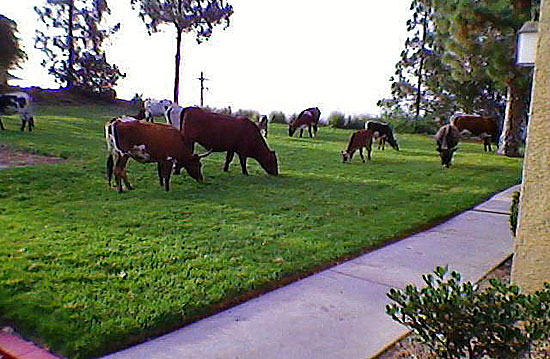
It's good to munch the green, green grass of Chatsworth, according to these visitors from a nearby ranch.
Meet Dave Diestel, lawman. He wears a sheriff’s star. And on Wednesday morning, the Los Angeles County sheriff’s deputy responded to a call straight out of the wild, wild West.
Fifteen head of cattle—bulls, cows and calves—were treating themselves to an all-you-can-graze buffet outside a sprawling apartment complex in Chatsworth.
“They were there for the grass,” said Diestel, a 10-year sheriff’s veteran assigned to the Malibu/Lost Hills station. “They went from green belt to green belt. The canyon is just so dry.”
The animals had made their first appearance the night before. Deputies, aided by county animal control workers and an apartment-dweller with a couple of herding dogs, thought they had successfully shooed the herd back up Browns Canyon.
No such luck.
So Deputy Diestel headed back to the scene Wednesday. As the cattle chowed down on the lush green lawns of the Summerset Village apartment complex, he set off on foot to see if he could determine where they’d come from.
“I couldn’t find anything back there, just mountains,” he said.
Suddenly, though, help appeared in the form of a woman who said she was the neighbor of the rancher whose cattle had wandered off.
The woman, armed with what Diestel described as an “Indiana Jones”-style bull whip, was able to persuade the cattle to git along.
“She drove them the rest of the way,” he said. “It was funny as heck.”
The woman with the whip and the rancher who owns the herd did not respond to calls seeking comment.
Ranna Issa, who manages the apartment complex, said residents seemed more amused than frightened by the bovine brigade.
“It was comical, to say the least,” Issa said. “They didn’t come near any residents…Really, it was just the grass they were after.”
As for Deputy Diestel, he was still marveling at the turn his morning shift had taken.
“It was all before breakfast,” he said. “I’ve never had to herd cattle before. That was definitely a first for me.”
8/22/12
Talking truth and power behind bars
August 22, 2012
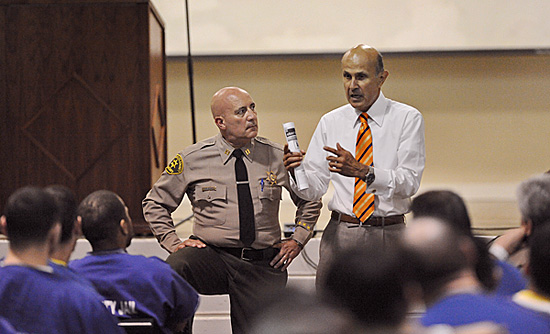
Sheriff Lee Baca, right, and Central Jail Captain Ralph Ornelas hold a "town hall meeting" with inmates.
Lee Baca is standing before a captive audience, sounding more like a preacher than the leader of the nation’s largest sheriff’s department.
“Start decorating your minds like you would a palace,” Baca implores a group of 90 inmates inside the archaic Men’s Central Jail. “Put positive things in there that will make you happy…I happen to believe you’re worth something.”
The men, seated shoulder-to-shoulder on metal pews in a jailhouse chapel, nod in agreement, giving the sheriff an appreciative hand to go along with their list of grievances. Earlier in the session, they’d complained to the boss about broken shower heads, uncomfortably cold air, inadequate “roof-time” recreation and deputies who, for seemingly no good reason, threaten to yank them out of the sheriff’s pet educational program.
Although the incarcerated men expressed gratitude for Baca’s appearance and assurances, the reaction to this “inmate town hall”—and the 173 others that have been convened during the past year—has been far less friendly among the sheriff’s other jail constituency: the deputies who work there.
Their union contends that the town halls have undermined the authority of deputies because inmates are being encouraged to, among other things, sidestep the chain of command, taking their complaints straight to higher-ups. The impact, according to union leaders: a potentially more dangerous workplace as frontline deputies lose the upper hand.
“They’ve never had the sheriff come in and say you can go talk to the captain,” Mark Divis, vice president of the Association of Los Angeles Deputy Sheriffs, says of the inmates. “The word from the top is that you can go right past those guys [the deputies] and we’ll come running…At what level do you realize that you’re not dealing with a large number of rational individuals? If you’re in a church, it’s a bad place to talk about Satan worship.”
According to a union survey presented to the Citizens’ Commission on Jail Violence, 71% of 447 responding deputies said Baca’s town halls had made inmates feel more “empowered” and less respectful. Forty-nine percent said inmates actually had become more hostile toward their jailers.
Baca has dismissed the survey as not fully representative of the roughly 2,000 deputies who serve inside the county’s jails. Still, the findings do suggest a cultural divide that poses a significant challenge for the sheriff as he tries to fix a jail system rocked by allegations of deputy brutality and mismanagement. Among the rank-and-file, Baca’s self-described humanist views are not always embraced.
In police circles nationwide, Baca is known as a fervent reformer who believes in the power of innovative educational programs to transform the lives of inmates and end their cycle of recidivism. He has a doctorate from USC in public administration and says his “second love” is teaching, which he’s done at various levels for more than 30 years.
The inmates he visited last week were part of an educational program that focuses on positive decision-making and self-esteem development. The participants live together in a dorm, not in the packed, dank cells that have drawn most of the scrutiny over deputy conduct.
For that reason, their town hall meeting had a more upbeat tone than most, with some inmates thanking Baca for the opportunity to learn an assortment of life skills for the first time, from job training to anger management. As one told the sheriff: “I’m the kind of guy who ends up in Vegas with three hookers and married to one.”
Baca began the town hall meetings last October as the furor over alleged deputy brutality escalated. Saying his subordinates had failed to inform him of the problems, Baca ordered a series of management and policy changes that have helped reduce incidents of significant force. Baca also backed the creation of the blue-ribbon jail commission by the Board of Supervisors, encouraging current and former members of the department to come forward with testimony critical of top supervisors.
As of late last week, according to Men’s Central Jail Captain Ralph Ornelas, 6,870 inmates had voluntarily attended the town hall meetings, which run about 30 minutes and are led by captains. Baca himself has presided over only a few.
“I’ve learned to listen to what they say,” Ornelas says of the inmate meetings. “Sometimes it has validity. Sometimes they have a certain agenda against a particular deputy.” Whatever the case, Ornelas says, he believes the meetings are valuable because if inmates “see you as a person, then they’re less apt do to do something to you.”
The captain has statistics on his side. The numbers show that not only have use of force incidents declined, so too have inmate assaults on deputies.
The jail commission’s general counsel, Richard Drooyan, says he sees the union’s resistance to the meetings as “a serious issue,” revealing the philosophical and managerial hurdles ahead for Baca.
“My view is that these meetings represent a positive development. They reduce tensions and that reduces violence,” Drooyan says, adding: “You change the culture by making sure supervisors are on board with your vision and that they tell their charges, ‘This is the way it’s going to be and if you don’t do it, you’ll be held accountable.”
Union leaders argue, however, that such views are better suited to the ivory tower than the central jail. The union’s executive director, Steve Remige, says many inmates simply won’t change their stripes no matter how much “the sheriff wants to teach them peace, love and freedom.”
Take, for example, the two inmates he says participated in Baca’s prized educational program, called MERIT—Maximizing Education Reaching Individual Transformation. “Just hours after graduating from MERIT,” Remige says, “they were caught trying to get some exposed metal under some ceiling tiles.” Remige says he assumes they were looking for materials to make jailhouse weapons.
Nonetheless, the problems in the jail have handed Baca a high-profile opportunity to showcase his reformer’s approach to incarceration. To that end, he invited Los Angeles County Supervisor Zev Yaroslavsky to observe last week’s town hall—and to say a few words at the end to the men participating in Baca’s educational program.
“The sheriff is trying to do something that is not conventional. On your shoulders rests the sustainability of this program,” the supervisor said. “He’s stuck his political reputation on the line by treating you like human beings…Don’t screw it up.”
Posted 8/16/12




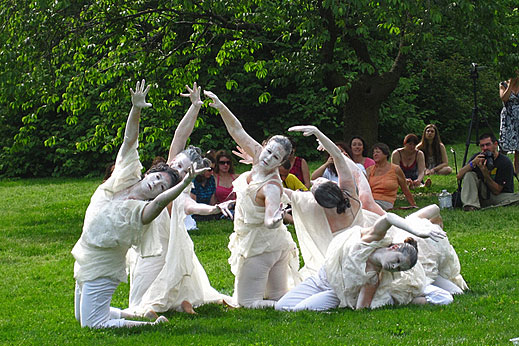












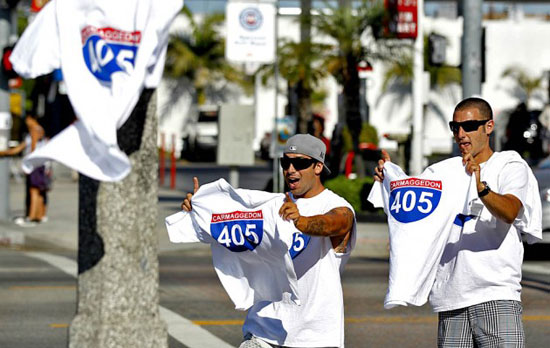
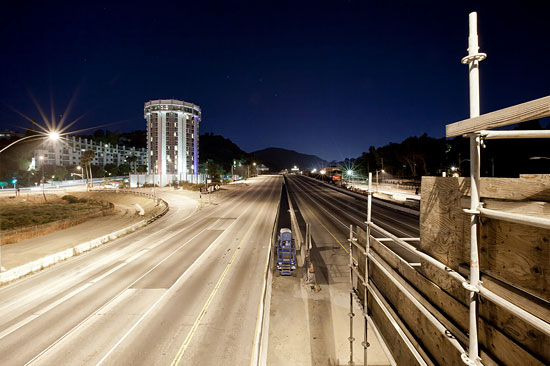

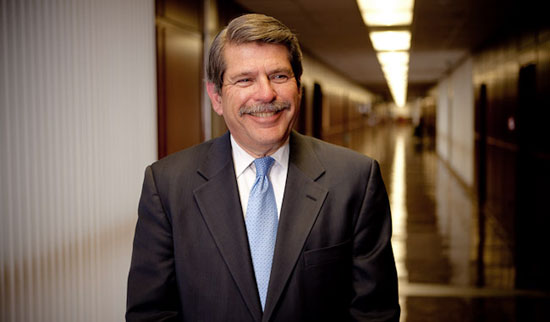

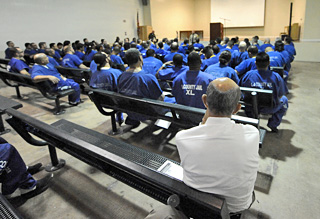
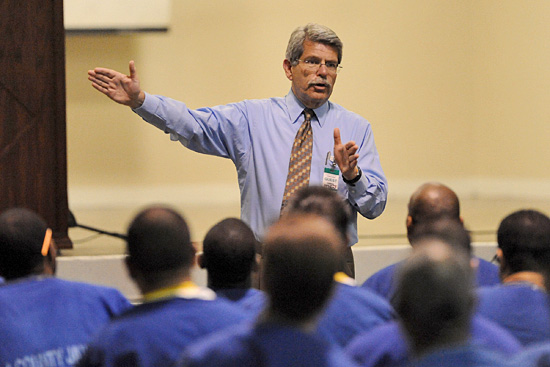





 Check for the latest closure information
Check for the latest closure information








